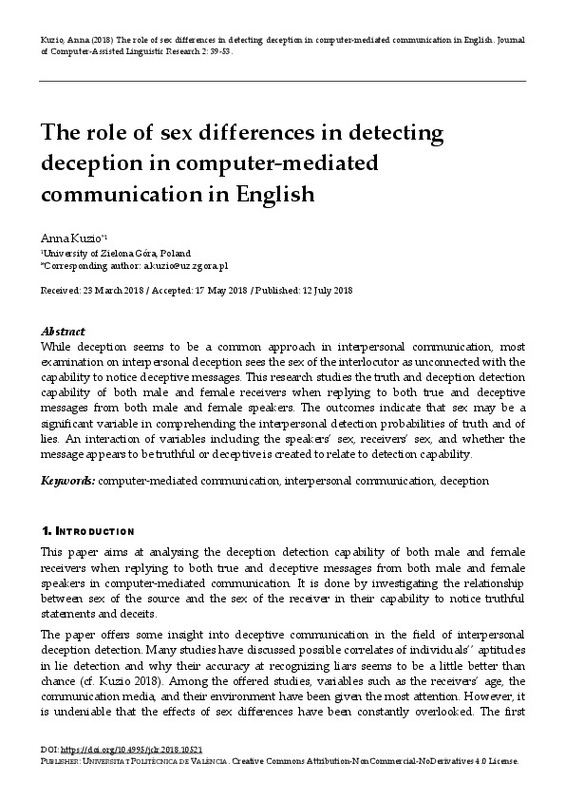Aamodt, M. G., & Custer, H. (2006). Who can best catch a liar? A meta-analysis of individual differences in detecting deception. The Forensic Examiner, 15(1), 6-11.
Blalock, H. M. (1972). Social Statistics. New York: McGraw Hill.
Bond, C. F., & DePaulo, B. M. (2006). Accuracy of deception judgments. Personality and Social Psychology Review, 10(3), 214-234. https://doi.org/10.1207/s15327957pspr1003_2
[+]
Aamodt, M. G., & Custer, H. (2006). Who can best catch a liar? A meta-analysis of individual differences in detecting deception. The Forensic Examiner, 15(1), 6-11.
Blalock, H. M. (1972). Social Statistics. New York: McGraw Hill.
Bond, C. F., & DePaulo, B. M. (2006). Accuracy of deception judgments. Personality and Social Psychology Review, 10(3), 214-234. https://doi.org/10.1207/s15327957pspr1003_2
Boush, D. M., Friestad, M., & Wright, P. (2009). Deception in the marketplace : The psychology of deceptive persuasion and consumer self-protection. New York: Routledge.
Camden, C., Motley, M. T., & Wilson, A. (1984). White lies in interpersonal communication: A taxonomy and preliminary investigation of social motivations. Western Journal of Speech Communication, 48(4), 309-325. https://doi.org/10.1080/10570318409374167
Carlson, J., George, J., Burgoon, J., Adkins, M., & White, C. (2004). Deception in computer mediated communication. Group Decision and Negotiation, 13, 5-28. https://doi.org/10.1023/B:GRUP.0000011942.31158.d8
Daft, R.L. & Lengel, R.H. (1986). Information richness: A new approach to managerial behavior and organizational design. In Cummings, L. L. & Staw, B.M. (Eds.), Research in organizational behavior 6 (pp. 191-233). Homewood, IL: JAI Press.
DePaulo, B. M., Epstein, J. A., & Wyer, M. M. (1993). Sex differences in lying: How women and men deal with the dilemma of deceit. In M. Lewis, & C. Saarni (Eds.), Lying and deception in everyday life (pp. 126-147). New York: Guilford Press.
DePaulo, B. M., Kashy, D. A., Kirkendol, S. E., Wyer, M. M., & Epstein, J. A. (1996). Lying in everyday life. Journal of Personality and Social Psychology, 70(5), 979- 995. https://doi.org/10.1037/0022-3514.70.5.979
DePaulo, B. M., Kirkendol, S. E., Tang, J., & O'Brien, T. P. (1988). The motivational impairment effect in the communication of deception: Replications and extensions. Journal of Nonverbal Behavior, 12(3), 177-202. https://doi.org/10.1007/BF00987487
DePaulo, B. M., Lassiter, G. D., & Stone, J. L. (1982). Attention all determinants of success at detecting deception and truth. Personality and Social Psychology Bulletin, 8(2), 273-279. https://doi.org/10.1177/0146167282082014
DePaulo, B. M., & Rosenthal, R. (1981). Telling lies. Journal of Personality and Social Psychology, 37(10), 1713-1722. https://doi.org/10.1037/0022-3514.37.10.1713
Dreber, A., & Johannesson, M. (2008). Gender differences in deception. Economics Letters, 99(1), 197-199. https://doi.org/10.1016/j.econlet.2007.06.027
Ekman, P., & O'Sullivan, M. (1991). Who can catch a liar? American Psychologist, 46(9), 913-920. https://doi.org/10.1037/0003-066X.46.9.913
Ekman, P., O'Sullivan, M., & Frank, M. G. (1999). A few can catch a liar. Psychological Science, 10(3), 263-266. https://doi.org/10.1111/1467-9280.00147
Feldman, R. S., Forrest, J. A., & Happ, B. R. (2002). Self-presentation and verbal deception: Do self-presenters lie more? Basic and Applied Social Psychology, 24(2), 163-170. https://doi.org/10.1207/153248302753674848
George, J. F., & Robb, A. (2008). Deception and computer-mediated communication in daily life. Communication Reports, 21(2), 92-103. https://doi.org/10.1080/08934210802298108
Hample, D. (1980). Purposes and effects of lying. Southern Speech Communication Journal, 46(1), 33-47. https://doi.org/10.1080/10417948009372474
Hancock, J., Thom-Santelli, J., & Ritchie, T. (2004). Deception and design: The impact of communication technology on lying behavior. In E. Dykstra-Erickson, & M. Tscheligi (Eds.), Proceedings of the 2004 conference on human factors in computing systems (pp. 129-134). New York: Association for Computing Machinery.https://doi.org/10.1145/985692.985709
Haselton, M. G., Buss, D. M., Oubaid, V., & Angleitner, A. (2005). Sex, lies, and strategic interference: The psychology of deception between the sexes. Personality and Social Psychology Bulletin, 31(1), 3-23. https://doi.org/10.1177/0146167204271303
Inglehart, R., Basa-ez, M., & Moreno, A. (1998). Human values and beliefs: A crosscultural sourcebook. Ann Arbor, MI: University of Michigan Press. https://doi.org/10.3998/mpub.14858
Knapp, L. M., Hart, R. P., & Dennis, H. S. (1974). An exploration of deception as a communication construct. Human Communication Research, 1(1), 15-29. https://doi.org/10.1111/j.1468-2958.1974.tb00250.x
Kraut, R. E. (1980). Behavioral roots of person perception: The deception judgments of customs inspectors and laymen. Journal of Personality and Social Psychology, 39(5), 784-798. https://doi.org/10.1037/0022-3514.39.5.784
Kuzio, A. (2018). Cross-cultural Deception in Polish and American English in Computer-Mediated Communication. New Castle upon Tyne: Cambridge Scholars Publishing.
Levine, T. R., & Kim, R. K. (2010). Some considerations for a new theory of deceptive communication. In M. S. McGlone, & M. L. Knapp (Eds.), The interplay of truth and deception: New agendas in theory and research (pp. 16-34). New York: Routledge.
Levine, T. R., Park, H. S., & McCornack, S. A. (2006). Accuracy in detecting truths and lies: Documenting the "Veracity Effect". Communication Monographs, 66(2), 125- 144. https://doi.org/10.1080/03637759909376468
Manstead, A., Wagner, H. L., & McDonald, C. J. (1986). Deceptive and non-deceptive communications: Sending experience, modality, and individual abilities. Journal of Nonverbal Behavior, 10(3), 147-167. https://doi.org/10.1007/BF00987612
McCornack, S. A., & Parks, M. R. (1990). What women know that men don't: Sex differences in determining the truth behind deceptive messages. Journal of Social and Personal Relationships, 7(1), 107-118. https://doi.org/10.1177/0265407590071006
Park, H. S., Levine, T. R., McCornack, S. A., Morrison, K., & Ferrara, M. (2002). How people really detect lies. Communication Monographs, 69(2), 144-157. https://doi.org/10.1080/714041710
Prater, T., & Kiser, S. B. (2002). Lies, lies, and more lies. SAM Advanced Management Journal,67(2), 9-36.
Sanchez-Pages, S., & Vorsatz, M. (2008). Enjoy the silence: An experiment on truthtelling. Experimental Economics, 12(2), 220-241. https://doi.org/10.1007/s10683-008-9211-7
Seiter, J. S., Bruschke, J., & Bai, C. (2002). The acceptability of deception as a function of perceivers' culture, deceiver's intention, and deceiver-deceived relationship. Western Journal of Communication, 66(2), 158-180. https://doi.org/10.1080/10570310209374731
Serota, K. B., Levine, T. R., & Boster, F. J. (2010). The prevalence of lying in America: Three studies of self-reported lies. Human Communication Research, 36(1), 2-25. https://doi.org/10.1111/j.1468-2958.2009.01366.x
Turner, R. E., Edgley, C., & Olmstead, G. (1975). Information control in conversations: Honesty is not always the best policy. Kansas Journal of Sociology, 11(1), 69-89.
https://doi.org/10.17161/STR.1808.6098
Zuckerman, M., DePaulo, B. M., & Rosenthal, R. (1981). Verbal and nonverbal communication of deception. In L. Berkowitz (Ed.), Advances in experimental social psychology (volume 11, pp. 1-59). New York: Academic Press.
https://doi.org/10.1016/S0065-2601(08)60369-X
[-]








